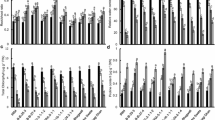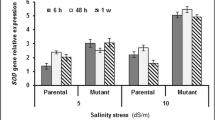Abstract
To keep pace with ever growing global population, progressive and sustained increase in rice production is necessary, especially in areas with extremely variable climatic conditions, where rice crop suffers from numerous abiotic stresses including salinity. Designing an effective phenotyping strategy requires thorough understanding of plant survival under stress. The investigation was carried out with four rice cultivars namely FR13A, IR42, Rashpanjor, and Pokkali that differed in salinity tolerance. The study showed that a genotype with initial vigour had some advantage in preserving shoot biomass under salt stress. Though both FR13A and IR42 showed sensitivity to salinity, FR13A with higher initial biomass maintained greater dry weight under saline condition. Increase of Na+:K+ ratio under salinity, due to accelerated absorption of Na+ and lesser absorption of K+ compared to control, was considerably higher in susceptible (118–200 %) than in tolerant (33–48 %) genotypes. While Na+ concentration in shoot increased significantly in both tolerant and susceptible genotypes, decrease in shoot K+ content was noticed only in susceptible genotypes. The imbalance of Na+ and K+ contents led to increased H2O2 production, causing greater peroxidation of membrane lipids and reduction in chlorophyll content and CO2 photosynthetic rate. Certain chlorophyll fluorescence parameters could distinguish between salinity tolerant and sensitive genotypes. To protect the plant from oxidative damage, several enzymatic and nonenzymatic antioxidants such as ascorbate were involved. The genotypes with capacity to assemble antioxidant enzymes in time could detoxify the reactive oxygen species more efficiently, leading to greater protection and reduced impact of salt stress.








Similar content being viewed by others
References
Abogadallah GM (2010) Antioxidative defense under salt stress. Plant Signal Behav 5:369–374
Amirjani MR (2011) Effects of salinity stress on growth, sugar content, pigments and enzyme activity of rice. Intl J Bot 7:73–81
Cakmak I, Marschner H (1993) Effect of zinc nutritional status on activities of superoxide radical and hydrogen peroxide scavenging enzyme in bean. Plant Soil 155–156:127–130
Choudhury SR, Choudhuri MA (1985) Hydrogen peroxide metabolism as an index of water stress tolerance in jute. Physiol Plant 65:503–507
Damanik RI, Maziah M, Ismail MR, Ahmad S, Zain AM (2010) Responses of the antioxidative enzymes in malaysian rice (Oryza sativa L.) cultivars under submergence condition. Acta Physiol Plant 32:739–747
Douglas I (2009) Climate change, flooding and food security in south Asia. Food Sec 1:127–136
FAO (2000) FAO World Soil Resources Report. ftp://ftp.fao.org/agl/agll/docs/wsr.pdf
Foyer CH, Halliwell B (1976) The presence of glutathione and glutathione reductase in chloroplast: a proposed role in ascorbic acid metabolism. Planta 133:21–25
Giannopolitis CN, Ries SK (1977) Superoxide dismutase occurrence in higher plants. Plant Physiol 59:309–314
Gill SS, Tuteja N (2010) Reactive oxygen species and antioxidant machinery in abiotic stress tolerance in crop plants. Plant Physiol Biochem 48:909–930
Gilmore AM, Hazlett TL, Debrunner PG, Govindjee (1996) Comparative time-resolved photosystem II chlorophyll a fluorescence analyses reveal distinctive differences between photoinhibitory reaction center damage and xanthophyll cycle-dependent energy dissipation. Photochem Photobiol 64:552–563
Gregorio GB, Senadhira D, Mendoza RD (1997) Screening rice for salinity tolerance, international rice research institute discussion paper Series No 22. International Rice Research Institute, Los Banόs
Heath RL, Packer L (1968) Photoperoxidation in isolated chloroplast: I. kinetics and stoichiometry of fatty acid peroxidation. Arch Biochem Biophys 125:189–198
Mahata KR, Singh DP, Saha S, Ismail AM, Haefele SM (2010) Improving rice productivity in the coastal saline soils of the mahanadi delta of India through integrated nutrient management. In: Hoanh TC, Szuster BW, Suan-Peng K, Ismail AM, Noble AD (eds) Tropical deltas and coastal zones: food production, communities and environment at the land–water interface, vol 9., CABIOxfordshire, UK, pp 239–248
Miller G, Suzuki N, Rizhsky L, Hegie A, Koussevitzky S, Mittler R (2007) Double mutants deficient in cytosolic and thylakoid acsorbate peroxidase reveal a complex mode of interaction between reactive oxygen species, plant development and a response to abiotic stress. Plant Physiol 144:1777–1785
Mitsuya S, Kawasaki M, Taniguchi M, Miyake H (2003) Relationship between salinity-induced damages and aging in rice leaf tissues. Plant Prod Sci 6:213–218
Munns R, Tester M (2008) Mechanisms of salinity tolerance. Annu Rev Plant Biol 59:651–681
Nakano Y, Asada K (1981) Hydrogen peroxide is scavenged by ascorbate specific peroxidase in spinach chloroplasts. Plant Cell Physiol 22:867–880
Nakhoda B, Leung H, Mendioro MS, Mohammadi-nejad G, Ismail AM (2012) Isolation, characterization, and field evaluation of rice (Oryza sativa L., Var. IR64) mutants with altered responses to salt stress. Field Crops Res 127:191–202
Oukarroum A, Madidi SE, Schansker G, Strasser RJ (2007) Probing the responses of barley cultivars (Hordeum vulgare L.) by chlorophyll a fluorescence OLKJIP under drought stress and re-watering. Environ Exp Bot 60:438–446
Porra RJ (2002) The chequered history of the development and use of simultaneous equations for accurate determination of chlorophylls a and b. Photosynth Res 73:149–156
Rao MV, Hale BA, Ormrod DP (1995) Amelioration of ozone-induced oxidative damage in wheat plants grown under high carbon dioxide: role of antioxidant enzyme. Plant Physiol 109:421–432
Sarkar RK (1998) Saccharide content and growth parameters in relation with flooding tolerance in rice. Biol Plant 40:597–603
Sarkar RK, Bhattacharjee B (2011) Rice genotypes with Sub1 QTL differ in submergence tolerance, elongation ability during submergence, and re-generation growth at re-emergence. Rice. doi:10.1007/s12284-011-9065-z
Sarkar RK, Panda D (2009) Distinction and characterisation of submergence tolerant and sensitive rice cultivars, probed by the fluorescence OJIP rise kinetics. Func Plant Biol 36:222–233
Sarwar GM, Khan MH (2007) Sea level rise: a threat to the coast of Bangladesh. Intl Asienforum 38:375–397
Shigeoka S, Yokota A, Nakano Y, Kitaoka S (1979) The effect of illumination on the L-ascorbic acid content in Euglena gracillis Z. Agric Biol Chem 43:2053–2058
Smirnoff N (1996) The function and metabolism of ascorbic acid in plants. Ann Bot 78:661–669
Strasser RJ, Srivastava A, Tsimilli-Michael M (2000) The fluorescence transient as a tool to characterize and screen photosynthetic samples. In: Yunus M, Pathre U, Mohanty P (eds) Probing photosynthesis: mechanism, regulation and adaptation. Taylor and Francis, London, pp 443–480
Türkana I, Demiral T (2009) Recent developments in understanding salinity tolerance. Environ Exp Bot 67:2–9
Vaidyanathan H, Sivakumar P, Chakrabarty R, Thomas G (2003) Scavenging of reactive oxygen species in NaCl-stressed rice (Oryza sativa L.)-differential response in salt-tolerant and sensitive varieties. Plant Sci 165:1411–1418
Wassmann R, Jagadish SVK, Heuer S, Ismail AM, Redona E, Serraj R, Singh RK, Howell G, Pathak H, Sumfleth K (2009) Climate change affecting rice production: the physiological and agronomic basis for possible adaptation strategies. Adv Agron 101:60–122
Xing D, Wu Y (2012) Photosynthetic response of three climber plant species to osmotic stress induced by polyethylene glycol (PEG) 6000. Acta Physiol Plant 34:1659–1668
Yamane K, Mitsuya S, Kawasaki M, Taniguchi M, Miyake H (2009) Antioxidant capacity and damages caused by salinity stress in apical and basal regions of rice leaf. Plant Prod Sci 12:319–326
Yoshida S, Forno D, Cock J, Gomez KA (1976) Laboratory manual for physiological studies of rice. International Rice Research Institute, Los Banόs
Zeng L, Shannon MC, Lesch SM (2001) Timing of salinity stress affecting rice growth and yield components. Agric Water Manage 48:191–206
Acknowledgments
Authors are grateful for financial support partly from the National Initiative on Climate Resilient Agriculture project (ICAR, New Delhi) and partly from the Central Rice Research Institute, Cuttack.
Author information
Authors and Affiliations
Corresponding author
Additional information
Communicated by W. Filek.
Rights and permissions
About this article
Cite this article
Sarkar, R.K., Mahata, K.R. & Singh, D.P. Differential responses of antioxidant system and photosynthetic characteristics in four rice cultivars differing in sensitivity to sodium chloride stress. Acta Physiol Plant 35, 2915–2926 (2013). https://doi.org/10.1007/s11738-013-1322-x
Received:
Revised:
Accepted:
Published:
Issue Date:
DOI: https://doi.org/10.1007/s11738-013-1322-x




